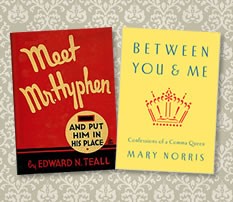The Comma Queen Meets Mr. Hyphen

For the past few weeks, language lovers have been luxuriating in the publication of Mary Norris's new book, Between You and Me: Confessions of a Comma Queen. Mary Norris is a longtime copy editor at The New Yorker, and her book takes us on a tour of her life working for that most elegant yet idiosyncratic publication, complete with observations about punctuation, spelling, editorial controversies, and the nature of language itself.
Merriam-Webster folks have been particularly delighted by the book. First, we enjoyed finding out that our Collegiate Dictionary has a nickname at The New Yorker – "Little Red Web." And we enjoyed hosting Mary at our office last spring, as she did her research into the history of dictionaries.
But mostly we take pleasure in being the ones responsible for introducing Mary to one of our all-time favorite books about the craft of editing: a 1937 gem titled Meet Mr. Hyphen (And Put Him in His Place), written by Edward N. Teall, a proofreader on the 1934 Webster's New International Dictionary, Second Edition.
When we told Mary about the book, she was appropriately appreciative, but little did we know how heartily she would embrace Mr. Hyphen and sing his praises. But here it is, on page 118:
The best thing ever written about hyphens is Meet Mr. Hyphen (And Put Him in His Place), by Edward N. Teall. ... [I]t may be the only full-length work on hyphens extant in English. ... Considering the rate at which the language changes, it is incredible that a study of hyphens from three generations ago remains relevant. Mr. Hyphen was onto something.
We take that as permission to offer a few of our favorite passages from Meet Mr. Hyphen. From the very first page Teall adopts a modest tone not unlike tone in Mary's book. Teall says:
I do not wish for a moment to be thought of as one presuming to tell writers and printers how they should compound. On the other hand, it would be cheap and cowardly to refrain from making my own choices clearly evident. I make no claim to sanctified authority, but write in the spirit of helpfulness.
A few pages later he offers some added perspective about his project and why he will not cowed by charges of logical inconsistency:
The English language is simply not logical. It is strong, free, and beautiful.
Still, it is clear that he takes the project seriously and wants us to do like likewise:
Good compounding is a manifestation of character. Sloppy compounding is apt to go with looseness of thought. Careful joining of words accompanies clarity of mental process. It prevents ambiguity and misunderstanding.
Teall and Mary agree that good compounding does not come from the overuse of hyphens. Good compounding often comes from knowing when to leave a compound open (note that she is a copy editor, two words, and agrees with Teall that no hyphens are required in compounds involving –ly adverbs – "closely watched indicator") or when to close it up (she knows that it is high time to close up lifestyle).
Hence Teall's advice that people "should regard Mr. Hyphen with neither fear nor disrespect."
They should cultivate his acquaintance – but keep him in his proper place. Don't let him crowd in where he doesn't belong, but insist on his doing what is expected of him. He's a good fellow, but he has to be watched.
In the final pages Teall tells us:
It all boils down to this, that compounding is an art, not an exact science. Personal preference, taste, and judgment are factors in it. Words cannot be weighed and measured, blended by fixed and unfailing formula.
Or, as Mary puts it in her discussion about whether it should be "blue stained glass" or "blue-stained glass":
If commas are open to interpretation, hyphens are downright Delphic.
Mr. Hyphen couldn't have said it better himself.
Read an excerpt of Between You & Me: Confessions of a Comma Queen by Mary Norris.



















